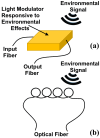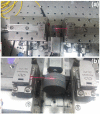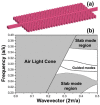Introduction to Photonics: Principles and the Most Recent Applications of Microstructures
- PMID: 30424385
- PMCID: PMC6187676
- DOI: 10.3390/mi9090452
Introduction to Photonics: Principles and the Most Recent Applications of Microstructures
Abstract
Light has found applications in data transmission, such as optical fibers and waveguides and in optoelectronics. It consists of a series of electromagnetic waves, with particle behavior. Photonics involves the proper use of light as a tool for the benefit of humans. It is derived from the root word "photon", which connotes the tiniest entity of light analogous to an electron in electricity. Photonics have a broad range of scientific and technological applications that are practically limitless and include medical diagnostics, organic synthesis, communications, as well as fusion energy. This will enhance the quality of life in many areas such as communications and information technology, advanced manufacturing, defense, health, medicine, and energy. The signal transmission methods used in wireless photonic systems are digital baseband and RoF (Radio-over-Fiber) optical communication. Microwave photonics is considered to be one of the emerging research fields. The mid infrared (mid-IR) spectroscopy offers a principal means for biological structure analysis as well as nonintrusive measurements. There is a lower loss in the propagations involving waveguides. Waveguides have simple structures and are cost-efficient in comparison with optical fibers. These are important components due to their compactness, low profile, and many advantages over conventional metallic waveguides. Among the waveguides, optofluidic waveguides have been found to provide a very powerful foundation for building optofluidic sensors. These can be used to fabricate the biosensors based on fluorescence. In an optical fiber, the evanescent field excitation is employed to sense the environmental refractive index changes. Optical fibers as waveguides can be used as sensors to measure strain, temperature, pressure, displacements, vibrations, and other quantities by modifying a fiber. For some application areas, however, fiber-optic sensors are increasingly recognized as a technology with very interesting possibilities. In this review, we present the most common and recent applications of the optical fiber-based sensors. These kinds of sensors can be fabricated by a modification of the waveguide structures to enhance the evanescent field; therefore, direct interactions of the measurand with electromagnetic waves can be performed. In this research, the most recent applications of photonics components are studied and discussed.
Keywords: biosensors; communications; fibers; light; photon; waveguides.
Conflict of interest statement
The authors declare no conflict of interest.
Figures















References
-
- Cavin S., Wang X., Zellweger M., Gonzalez M., Bensimon M., Wagnières G., Krueger T., Ris H., Gronchi F., Perentes J.Y. Interstitial fluid pressure: A novel biomarker to monitor photo-induced drug uptake in tumor and normal tissues. Lasers Surg. Med. 2017;49:773–780. doi: 10.1002/lsm.22687. - DOI - PubMed
-
- Mignon C., Tobin D.J., Zeitouny M., Uzunbajakava N.E. Shedding light on the variability of optical skin properties: Finding a path towards more accurate prediction of light propagation in human cutaneous compartments. Biomed. Opt. Express. 2018;9:852–872. doi: 10.1364/BOE.9.000852. - DOI - PMC - PubMed
-
- Zheludev N. The life and times of the LED—A 100-year history. Nat. Photonics. 2007;1:189–192. doi: 10.1038/nphoton.2007.34. - DOI
Publication types
LinkOut - more resources
Full Text Sources
Other Literature Sources

